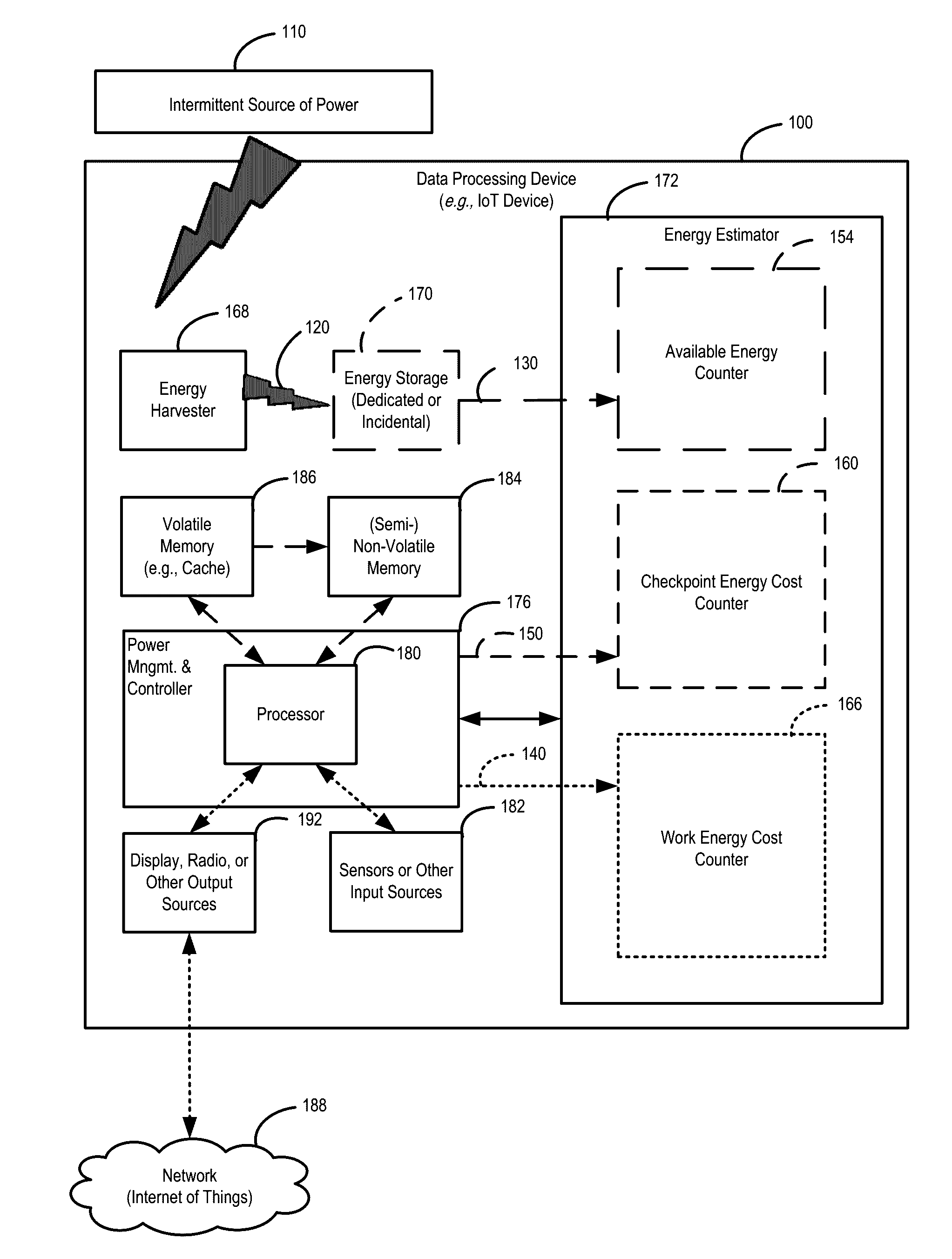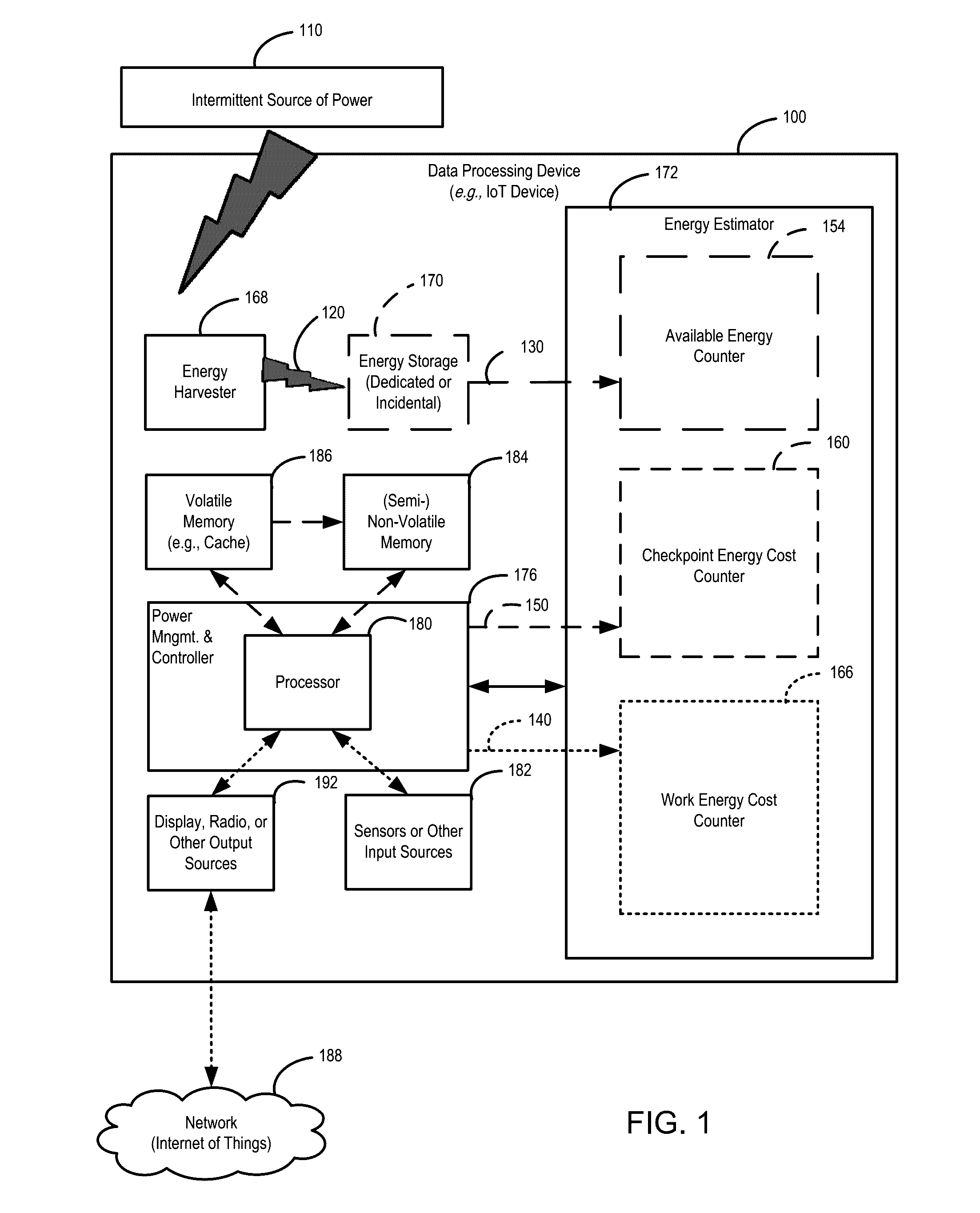Opportunistic power management for managing intermittent power available to data processing device having semi-non-volatile memory or non-volatile memory
a data processing device and intermittent power management technology, applied in the field of power management techniques in data processing systems, can solve the problems of long-life batteries contributing much weight and bulk, intermittent power often not remaining available, and inherently unpredictable intermittent sources
- Summary
- Abstract
- Description
- Claims
- Application Information
AI Technical Summary
Benefits of technology
Problems solved by technology
Method used
Image
Examples
case examples
OVERVIEW OF USE CASE EXAMPLES
[0074]Two example use cases are set forth as follows. Use case example no. 1 is fairly self-contained. It shows power management integrated with all device activity. This can be thought of as a tiny device or embedded use case (e.g., consistent with the data processing device 100, where simplicity is an important consideration). Use case example no. 2 describes a power management routine but not the application code because the application is ordinary code and need not be coded in any particular way to take advantage of power management. This latter use case example assumes hardware support in the form of a cache and a count of the number of modified cache lines. The second use case example may be thought of as a general-purpose device use case (e.g., for the computer system 500). In short, use case example no. 1 includes all parts in the sense that it is a full example of the system, whereas use case example no. 2 shows the energy management control loo...
use case example 1
[0075]This example could be hardware, software, or some combination of the two. If viewed as software, then instruction code (software) includes energy decisions explicitly—that is, pre-existing software may be tailored to include the energy decisions. The example assumes the following components: a radio, a temperature sensor, a non-volatile queue, and a volatile queue.
[0076]The energy consumed by each component is as follows, in the order low (least energy) to high (most energy): push (or pop, i.e., push / op) from volatile queue—assumed to have zero energy cost to simplify the example; push / pop from non-volatile queue—assumed to have a zero energy cost to simplify the example; read from temperature sensor; keep data in volatile memory (Le., storage or scrubbing cost); and transmit temperature sample on the radio. All other energy costs are assumed to be zero to simplify the example. In a practical system, there are other components that use energy, such as a so-called data processi...
use case example 2
[0097]In this example, there is a CPU (core) with a cache and memory (see, e.g., FIG. 5). The CPU may be running any program. The cache is volatile memory; the main memory is (semi-)NVM. Work advances fastest and most efficiently when it can write to the cache without writing to the main memory. When energy runs low, modified lines in the cache are written back to the main memory. Once all cache lines are written to memory, this checkpoints the progress so far. Power can be removed and reapplied and execution may resume. The checkpoint energy needed goes up according to the number of dirty cache lines,
[0098]Also, in this example, the application code is not shown. This is because the example expects the application to be written normally, without consideration of energy management. This demonstrates that the example is applicable for management of any code, without modification of the code so that it will work in an opportunistic power management deployment. An obstacle with prior a...
PUM
 Login to View More
Login to View More Abstract
Description
Claims
Application Information
 Login to View More
Login to View More - R&D
- Intellectual Property
- Life Sciences
- Materials
- Tech Scout
- Unparalleled Data Quality
- Higher Quality Content
- 60% Fewer Hallucinations
Browse by: Latest US Patents, China's latest patents, Technical Efficacy Thesaurus, Application Domain, Technology Topic, Popular Technical Reports.
© 2025 PatSnap. All rights reserved.Legal|Privacy policy|Modern Slavery Act Transparency Statement|Sitemap|About US| Contact US: help@patsnap.com



